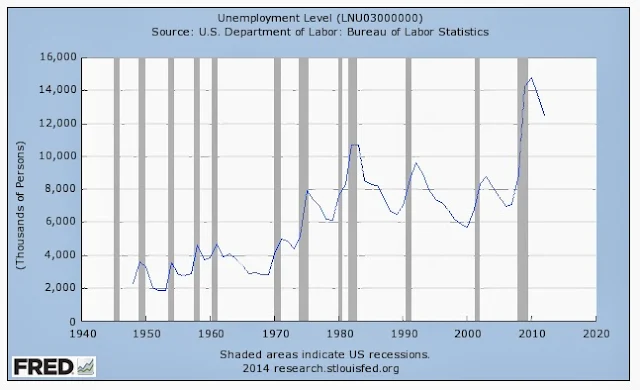Between July 2007 and July 2013, total credit market debt owed (TCMDO) has grown just 16%, by barely $8 trillion. It's the smallest increase on record for any six year period going back to when the data series begins in October 1949.
Going back six years from 2013 is instructive because the summer of 2007 was when the level of TCMDO last doubled (going back to the summer of 1999), and if you go back to the beginning of the data series you find doubling times of as few as 6 years in length to as many as almost 12. In other words, in a period of rapid credit expansion TCMDO might have conceivably doubled in our last six year period, but it hasn't. We sure could have used it. Instead it has for all intents and purposes collapsed, growing just $8 trillion from $50.032 trillion in 2007 to $58.082 trillion now.
From humble beginnings in 1949 when TCMDO stood at $400 billion, the level went on to double in the summers of 1961, 1970, 1977, 1983, 1989, 1999 and 2007. In order to double again (to a level of $102 trillion) by, say, 2019 (12 years from 2007), we're going to have to pick up the pace just a little . . .. Unless, of course, this debt-based economy has reached the limits of what it can do, which may be what the last six years is trying to tell us.
Here's the data for TCMDO for the six year periods going back to July 1953:
7/1/13 $58.1 trillion (up 16%)
7/1/07 $50.0 trillion (up 74%)
7/1/01 $28.8 trillion (up 58%)
7/1/95 $18.3 trillion (up 45%)
7/1/89 $12.6 trillion (up 102%)
7/1/83 $06.3 trillion (up 97%)
7/1/77 $03.2 trillion (up 87%)
7/1/71 $01.7 trillion (up 57%)
7/1/65 $01.1 trillion (up 49%)
7/1/59 $00.7 trillion (up 42%)
7/1/53 $00.5 trillion.
As Ambrose Evans-Pritchard formulated it in 2011, "debt draws forward prosperity". In other words, we've already enjoyed the prosperity years ago which should be present today by literally pulling it back there from here, and now that we're here, well, there's nothing here, except for a measly 0.97% real average GDP report for the six years 2007-2012.
Time to pay.





















